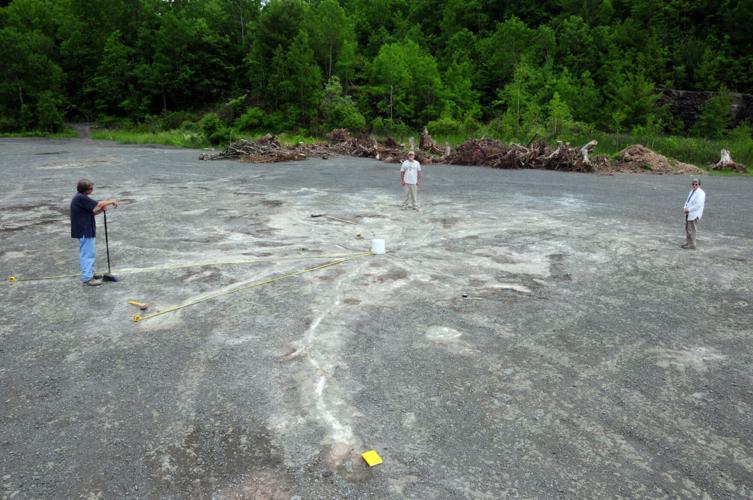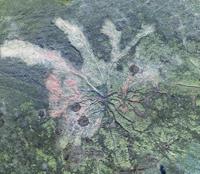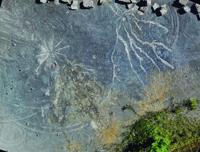CAIRO — Discovery of the fossilized remains of a prehistoric forest in Cairo has set the scientific world on its ear.
A research team from Binghamton University was sifting through fossil soils at a quarry behind the Cairo Highway Department when they discovered the root system of trees thought to be 385 million years old, dating back to the Devonian age, according to a release from Binghamton University.
Research at the site dates back more than a decade ago, senior lecturer of paleobotany at Cardiff University, Dr. Christohper Berry, said.
“I believe that it was Charles (Chuck) VerStraeten at the New York State Museum who found [the roots] originally,” Berry said. “Back in 2007 I asked the paleontologists at the NYSM to take me to Cairo as there was a report of a tiny little plant there that I wanted to follow up, and so we worked in a corner of the quarry for a couple of days over the next two years.”
VerStraeten discovered the roots in 2009, Berry said, which is when professor emeritus of biological science at Binghamton University William Stein became involved.
“The New York State Museum invited me to come out and take a look at something they had found,” Stein said. “They thought it might be of interest to me.”
Stein and his team were called away from 2010 to 2012 to work at a quarry in Gilboa, which had formerly been the home of the world’s oldest forest.
The Cairo site is about two to three million years older, Stein said.
“It was quarried until about 40 or 50 years ago,” Stein said. “It took some 40 years of weathering to become apparent what was there.”
Former EPA Regional Administrator Judith Enck found the discovery to be fascinating.
“It is very, very exciting to hear about this natural wonder discovery,” she said. “It is also a reminder of how important it is to protect the natural resources of the Catskills, both above and below ground,”
Local geologist David Walker said he believes the local landscape has brought us to a greater understanding of global transformation.
“It is nice to think that this transformation of land biota is visible locally even though it was a global transformation in progress,” he said. “Our local geology along the Helderberg Escarpment has played an important role in understanding the Earth’s geological history and this discovery is another chapter in that rich history.”
The Catskills are famous for Devonian fossils, Stein said.
“The Devonian Period represents a time in which the first forest appeared on planet Earth,” Stein said. “The effects were of first-order magnitude, in terms of changes in ecosystems, what happens on the Earth’s surface and oceans, CO2 concentration in the atmosphere and global climate. So many dramatic changes occurred at that time as a result of those original forests that basically, the world has never been the same since.”
The team’s findings were published in the scientific journal Current Biology.
Researchers identified three unique root systems at the site: a palm-like tree called Eospermatopteris that grew opportunistically like weeds, Archaeopteris that hinted at the seed-bearing plants to come 10 million years later and a tree belonging to the class Lyscopsida, which was previously thought to originate during the Carboniferous period, according to the university.
“What we have at Cairo is a rooting structure that appears identical to great trees of the Carboniferous coal swamps with fascinating elongate roots,” Stein said. “But no one has yet found body fossil evidence of this group this early in the Devonian. Our findings are perhaps suggestive that these plants were already in the forest, but perhaps in a different environment and earlier than generally believed. Yet we only have a footprint, and we await additional fossil evidence for confirmation.”
The Archaetoperis was also a very significant find, Berry said.
“It is the massive branching woody roots of the Archaeopteris tree, found at Cairo but not at Gilboa, which are the really important thing here,” Berry said. “This is the first time that such vast underground rooting structures are seen in a fossil forest. Archaeopteris also had a woody trunk and flat green leaves, unlike the Gilboa tree. It seems to have worked at a different physiological level.”
The research helps scientists have a better understanding of past environments, Stein said.
“It gives us a sense of the ecology of what Catskill delta forests were like,” Stein said. “Who was living with whom, what the spatial relationships were like. It’s not a matter of size, but a matter of which trees were doing what with who.”
The team’s findings can also be put into a more modern context of climate change, Berry said.
“The interactions of plant roots with soils, and the creation of wood, are both ways in which CO2 can be removed from the atmosphere on a long term basis,” Berry said. “This is important because over the course of the Devonian era, atmospheric CO2 levels fell from perhaps 10 times the level today to the same as today, and long-lived ice caps formed at the South Pole because of this. Many scientists believe that the rise of forests contributed greatly to this drop in CO2. Today we cut down forests, and let them burn, which is having the opposite effect.”
Stein and his team plan to continue to investigate the Catskills, he said.
“It seems to me, worldwide, many of these kinds of environments are preserved in fossil soils. And I’d like to know what happened historically, not just in the Catskills, but everywhere,” Stein said. “Understanding evolutionary and ecological history — that’s what I find most satisfying.”
Stein is hopeful that the town will develop the site as a resource for the community to learn from, he said.
Currently, the site is only accessible with permission, he said.
The research was supported by the Natural Environment Research Council of the United Kingdom.













